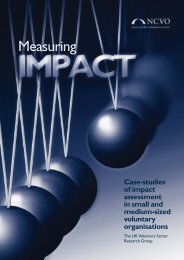A guide to third sector trading - WCVA
A guide to third sector trading - WCVA
A guide to third sector trading - WCVA
Create successful ePaper yourself
Turn your PDF publications into a flip-book with our unique Google optimized e-Paper software.
It’s an idea, but is it business? A <strong>guide</strong> <strong>to</strong> <strong>third</strong> sec<strong>to</strong>r <strong>trading</strong><br />
1: Getting<br />
started<br />
2: First steps 3: Business<br />
planning<br />
4: Legal and<br />
governance<br />
5: Funding<br />
and<br />
resourcing<br />
6: Financial<br />
controls<br />
7: Managing<br />
growth<br />
8: Management<br />
and<br />
governance<br />
9: Social<br />
enterprise<br />
10: Sources<br />
of support<br />
• When <strong>to</strong> use them: Budget moni<strong>to</strong>ring is useful in the following<br />
circumstances:<br />
− in the early days of <strong>trading</strong> when the manager and direc<strong>to</strong>rs<br />
need <strong>to</strong> know how close their business plan forecasts are<br />
<strong>to</strong> <strong>trading</strong> realities, so they can allow for timely adjustments<br />
<strong>to</strong> plans<br />
− whenever finance forecasting can be carried out reasonably<br />
reliably – eg when there are long term contracts and other<br />
stable <strong>trading</strong> conditions<br />
− when the financial situation is particularly tight: at these times<br />
regular reports against budget forecasts are usually essential,<br />
and managers should moni<strong>to</strong>r them weekly or even daily<br />
at times of crisis (this is not optional good practice: anyone<br />
who has been through a financial crisis in their business will<br />
confirm that this level of moni<strong>to</strong>ring is indispensible).<br />
• How much information?<br />
− the current period: A forecast for the current month or<br />
quarter is usually informative when set alongside the actual<br />
income and expenditure for the same period.<br />
− year <strong>to</strong> date: Totals so far during the financial year - both<br />
actual and forecast - give a more balanced picture than<br />
monthly <strong>to</strong>tals alone, and are well worth preparing and<br />
circulating (though it is tricky <strong>to</strong> fully au<strong>to</strong>mate the monthly<br />
updating on spreadsheet-based systems)<br />
− month-by-month budget reports: It is possible <strong>to</strong> bring<br />
<strong>to</strong>gether all the monthly reports so far the current year, and<br />
include forecasts for the full year on a single sheet – and<br />
this may be useful for the detailed discussions of a finance<br />
subcommittee. But it is rarely useful for a full board meeting<br />
<strong>to</strong> have so much information in front of it. (One way <strong>to</strong><br />
draw attention <strong>to</strong> just the current period is <strong>to</strong> use a coloured<br />
highlight or shading. But there is still a risk of producing<br />
information overload for direc<strong>to</strong>rs.)<br />
− ‘same period last year’: Seasonal businesses in particular can<br />
benefit from reports which contain less budget information,<br />
but include a column or columns for comparable income<br />
and expenditure details for the same period last year and/<br />
or several previous years. This can highlight the growth or<br />
decline of different <strong>trading</strong> activities and focus attention on<br />
advertising and promotion issues.<br />
161












